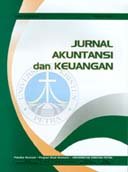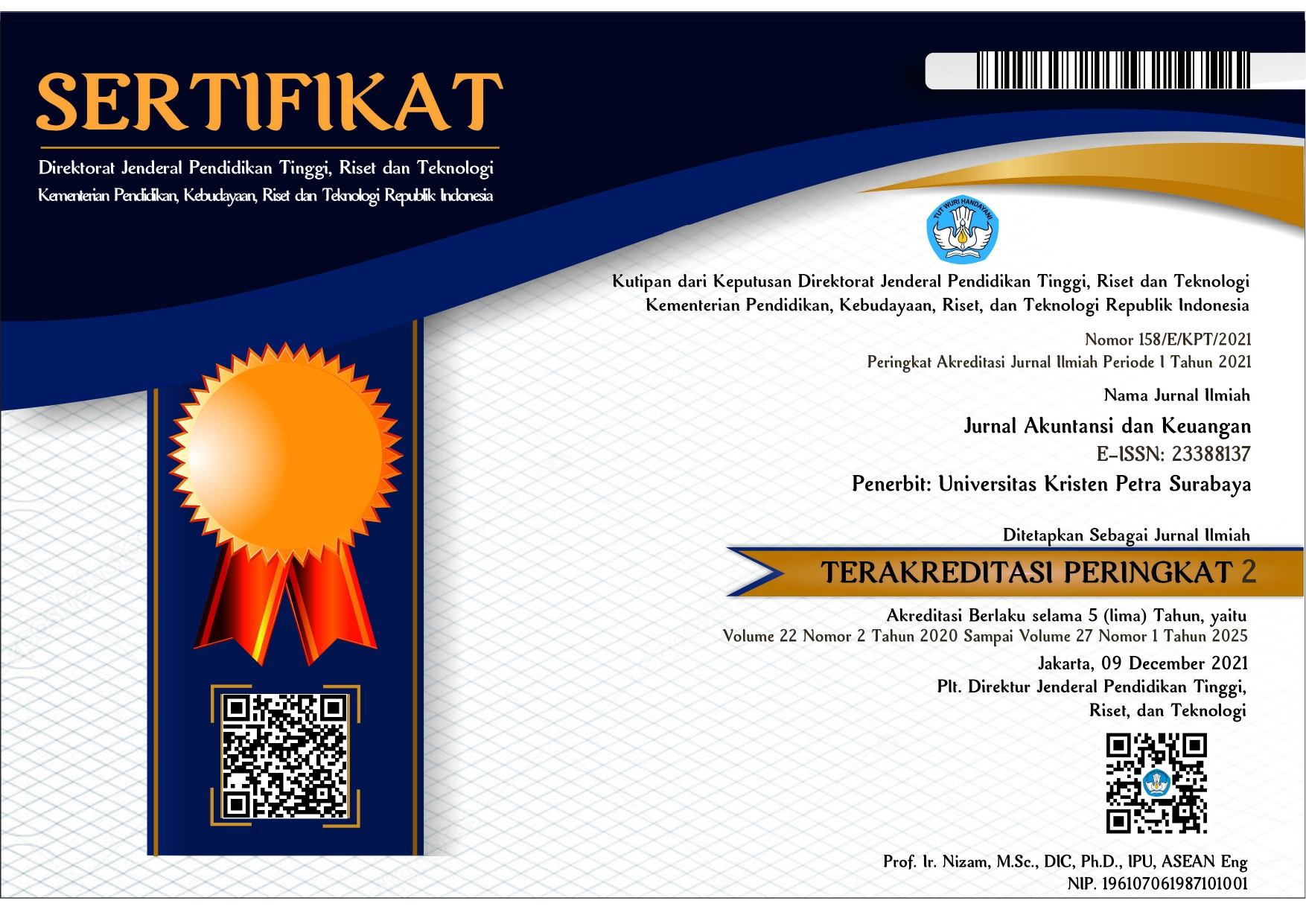Key Determinants of Indonesia’s Banks Financial Performance
DOI:
https://doi.org/10.9744/jak.21.2.58-67Keywords:
Bank comparisons, capital quality, financial ratios, indonesia banking, loan quality, principal component analysis, profitability, JEL, G21, C38, D22Abstract
Depositors, investors, as well as public in general need easily accessible indicators that are important to differentiate various banks. This research addresses simultaneously two important issues: analyzing and identifying which key publicly available financial indicators of banks are important, as well as approximating the weight of the aforementioned indicators when banks’ comparisons are to be made. Utilizing the recent 2017 database from 90 conventional banks, this study analyzes 17 banking ratios using the method of principal component analysis. The calculations show that five components explain around 75 percent of total variation in the data. Those five components represent indicators on profitability, quality of capital, quality of loans, fee-based activities, and liquid assets in the balance sheets. Further, by combining five principal components, the result shows that even small banks can achieve good financial performances.
References
Abdi, H., and Williams, L. J. (2010). Principal component analysis. Wiley interdisciplinary reviews: computational statistics, 2(4), 433–459. doi: https://doi.org/10.1002/wics.101
Alfansi, L., and Sargeant, A. (2000). Market segmentation in the Indonesian banking sector: the relationship between demographics and desired customer benefits. International Journal of Bank Marketing, 18(2), 64–74. doi: https://doi.org/10.1108/02652320010322976
Benink, H., and Wihlborg, C. (2002). The new Basel capital accord: making it effective with stronger market discipline. European Financial Management, 8(1), 103–115. doi: https://doi.org/ 10.1111/1468-036X.00178
Demirgüç-Kunt, A., and Huizinga, H. (2004). Market discipline and deposit insurance. Journal of Monetary Economics, 51(2), 375–399. doi: https://doi.org/10.1016/j.jmoneco.2003.04.001
Dewi, F. S., Arifati, R., and Andini, R. (2016). Analysis of Effect of CAR, ROA, LDR, Company Size, NPL, and GCG to Bank Profitability (Case Study on Banking Companies Listed in BEI Period 2010-2013). Journal Of Accounting, 2(2). http://jurnal.unpand.ac.id/ index.php/AKS/article/view/465
Dietrich, A., and Wanzenried, G. (2011). Determinants of bank profitability before and during the crisis: Evidence from Switzerland. Journal of International Financial Markets, Institutions and Money, 21(3), 307–327. doi: https://doi.org/10.1016/j.intfin.2010.11.002
Firmansyah, G., Hasibuan, Z. A., and Sucahyo, Y. G. (2014). Indonesia e-Government components: A principal component analysis approach. In Information Technology Systems and Innovation (ICITSI), 2014 International Conference on (pp. 148–152). IEEE. doi: https://doi.org/10.1109/ICITSI.2014.7048255
Gasbarro, D., Sadguna, I. G. M., and Zumwalt, J. K. (2002). The changing relationship between CAMEL ratings and bank soundness during the Indonesian banking crisis. Review of Quantitative Finance and Accounting, 19(3), 247–260.
Johnson, R. A., Johnson, R. A., and Wichern, D. W., Applied multivariate stastistical analysis, Prentice-Hall of India Private Limited., 2003.
Leon, S. J., Linear algebra with applications, eight edition, Prentice Hall, Inc., New Jersey, 2010. doi: https://doi.org/10.1080/1062936060 0678310
Mihailović, N. (2016). Ranking of banks in Serbia. Yugoslav Journal of Operations Research, 19(2). http://www.yujor.fon.bg.ac.rs/index. php/yujor/article/download/330/221
Otoritas Jasa Keuangan. (2016). Peraturan otoritas jasa keuangan nomor 6 /pojk.03/2016 tentang kegiatan usaha dan jaringan kantor berdasarkan modal inti bank. Indonesia. https://www.ojk.go.id/id/kanal/perbankan/regulasi/peraturan-ojk/Documents/Pages/pojk-kegiatan-usaha-dan-jaringan-kantor-berdasarkan-modal-inti-bank/SALINAN-POJK.6 BUKU.pdf
Otoritas Jasa Keuangan. (2017). Statistik Perbankan Indonesia. Jakarta. http://www. ojk.go.id/id/kanal/perbankan/data-dan-statistik/statistik-perbankan-indonesia/Pages/ Statistik-Perbankan-Indonesia---November-2017.aspx
Patrick, H. (1997). Banking System Failures in Developing and Transition Countries; Diagnosis and Predictions. BIS Economic Paper.
Petroni, A., and Braglia, M. (2000). Vendor selection using principal component analysis. Journal of supply chain management, 36(1), 63–69. doi: https://doi.org/10.1111/j.1745-493X. 2000.tb00078.x
Rochet, J.-C. (2004). Macroeconomic shocks and banking supervision. Journal of Financial Stability, 1(1), 93–110. doi: https://doi.org/ 10.1016/j.jfs.2004.06.004
Rojas-Suarez, L. (2002). Rating banks in emerging markets: What credit rating agencies should learn from financial indicators. In Ratings, rating agencies and the global financial system (pp. 177–201). Springer.
Said, R. M., and Tumin, M. H. (2011). Performance and financial ratios of commercial banks in Malaysia and China. International Review of Business Research Papers, 7(2), 157–169. https://www.bizresearchpapers.com/ 11. Rasidah-FINAL.pdf
Sastrosuwito, S., and Suzuki, Y. (2011). Post crisis Indonesian banking system profitability: bank-specific, industry-specific, and macroeconomic determinants. In The 2nd International Research Symposium in Service Management (pp. 588–597). https://www.researchgate.net/ profile/Yasushi_Suzuki3/publication/267566466_Post_Crisis_Indonesian_Banking_System_Profitability_Bank-Specific_Industry-Specific_and_Macroeconomic_Determinants/links/549d1d410cf2fedbc30ff693.pdf
Sato, Y. (2005). Bank restructuring and financial institution reform in Indonesia. The Developing Economies, 43(1), 91–120. doi: https://doi.org/10.1111/j.17461049.2005.tb00254.x
Sharma, S., and Sharma, S. (1996). Applied multivariate techniques. John Wiley & Sons. ISBN: 978-0471310648.
Shlens, J. (2014). A tutorial on principal component analysis. arXiv preprint arXiv:1404. 1100.
Stork, D. G., Hart, P. E., and Duda, R. O., Pattern Classification, Second Edition, John Wiley & Sons. ISBN: 978-0471056690.
Stoica, O., Mehdian, S., and Sargu, A. (2015). The impact of internet banking on the performance of Romanian banks: DEA and PCA approach. Procedia Economics and Finance, 20, 610–622. https://www.science-direct.com/science/article/pii/S221256711500115X
Teo, L. E., Enoch, C., Lindgren, C.-J., Baliño, T. J. T., Gulde, A. M., and Quintyn, M. G. (2000). Financial Sector Crisis and Restructuring; Lessons from Asia: Lessons from Asia. International Monetary Fund. https://www. imf.org/en/Publications/Occasional-Papers/ Issues/2016/12/30/Financial-Sector-Crisis-and-Restructuring-Lessons-from-Asia-Lessons-from-Asia-3395
Tsai, C.-F. (2009). Feature selection in bankruptcy prediction. Knowledge-Based Systems, 22(2), 120–127. doi: https://doi.org/10.1016/ j.knosys.2008.08.002
Ueda, T., and Hoshiai, Y. (1997). Application of principal component analysis for parsimonious summarization of DEA inputs and/or outputs. Journal of the Operations Research Society of Japan, 40(4), 466–478. https://www. jstage.jst.go.jp/article/jorsj/40/4/40_KJ00001203119/_article/-char/ja/
Victor, S., Zhang, Q., and Mingxing, L. (2007). Comparing the performance of Chinese banks: a principal component approach. China Economic Review, 18(1), 15–34. doi: https://doi.org/10.1016/j.chieco.2006.11.001
Von Luebke, C. (2010). The politics of reform: political scandals, elite resistance, and presidential leadership in Indonesia. Journal of Current Southeast Asian Affairs, 29(1), 79–94. http://journals.sub.uni-hamburg.de/giga/jsaa/ article/view/210
Widiarti, A. W., Siregar, H., and Andati, T. (2015). The determinants of bank’s efficiency in indonesia. Bulletin of Monetary Economics and Banking, 18(2), 129–156. doi: https://doi. org/10.21098/bemp.v18i2.520
World Bank. (2016). World Development Indicators 2016, World Bank. doi: 10.1596/978-0-8213-7386-6
Yazici, B., and Yolacan, S. (2007). A comparison of various tests of normality. Journal of Statistical Computation and Simulation, 77(2), 175–183. doi: https://doi.org/10.1080/ 10629360600678310
Yoshino, N., and Taghizadeh-Hesary, F. (2015). Analysis of credit ratings for small and medium-sized enterprises: Evidence from Asia. Asian Development Review, 32(2), 18–37. doi: https://doi.org/10.1162/ADEV_a_00050.
Downloads
Published
How to Cite
Issue
Section
License
Authors who publish with this journal agree to the following terms:
- Authors retain the copyright and publishing right, and grant the journal right of first publication with the work simultaneously licensed under a Creative Commons Attribution License that allows others to share the work with an acknowledgement of the work's authorship and initial publication in this journal.
- Authors are able to enter into separate, additional contractual arrangements for the non-exclusive distribution of the journal's published version of the work (e.g., post it to an institutional repository or publish it in a book), with an acknowledgement of its initial publication in this journal.
- Authors are permitted and encouraged to post their work online (e.g., in institutional repositories or on their website) followingthe publication of the article, as it can lead to productive exchanges, as well as earlier and greater citation of published work (See The Effect of Open Access).<a href="http://creativecommons.org/lice















